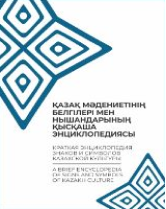
Blacksmithing
In ancient times blacksmiths were held in high esteem and honour. The scholarly research of the blacksmith phenomenon and his role in the Turkic culture in recent years allows to speak of his high semantic status, his representation as a shaman (baqsy) and even a demiurge.
The Kazakh darhan ūsta took part in many rites and rituals. In particular, its role was prominent in maternity rites and initiation rituals. At the same time, the forge was among the objects of special veneration, which has been preserved in the everyday life of the inhabitants of South Kazakhstan up to the present day. The field researches of the members of the research group of the MSHE project AR09259862 “Research of traditional crafts of modern Kazakhstan: the state and search for ways of preservation” carried out in Kyzylorda region allow talking about the preservation of this phenomenon. Folks still believe that a blacksmith
and jeweler receive their gift from the Almighty. The Kazakh darhan ūsta considered a mythological and folklore character, the prophet David (Däuit), to be their patron-peer.
If we turn to the products of Kazakh blacksmiths, even they performed meaningful functions. In traditional culture, weapons performed multifaceted functions: social, ritual and ceremonial, magical and others. It is known from a variety of sources, weapons were an element of identification in tribal, social and, of course, a sign of power. People who received the right to bear arms, enjoyed special privileges in society.
The Kazakhs distinguish five main types of military weapons: throwing, cutting, chopping, stabbing and striking. Figuratively, this set of weapons is called “bes qaru”.
In the olden days, steel smiths forged curved sabres – qylysh, swords – selebe, and broadswords – semser. Daggers – qanzhar, long knives with a curved blade – zheke auyz, and long narrow knives – bunda pyshaq, were popular. The most widespread implements were the sadaq – bow and arrows, while the nayza – spear had a steel tip.
The steel was used to make unique curved sabres, which are referred to as almas qylysh in the Kazakh folk epic. Their handles and hilt were decorated with precious stones. The hilt was covered with reliefs, e.g. with the image of an eagle’s head. The hilt was made of black or red leather with embossed decoration and covered with silver or bronze plaques.
Also, the traditional arms complex of the Kazakhs included: leather and metal armour, steel helmets with a net and visor, and wooden and leather shields lined with iron plates. These are all the products of blacksmiths and armourers. The weapons of the best craftsmen were highly valued.
The Kulmenovs brothers, who live in Almaty, stand out among the modern master blacksmiths (practically the only ones). They are engaged in making all kinds of traditional Turkic weapons. They are fighting axes-aybalta, lances-naiza, drums, maces and knuckles with the tips from raw leather doiyr and from iron saqeter, wooden fighting sticks shoqpar, shields, helmets, iron arm-bands and many other things. The main customers of their production are local history museums, collectors, folklore groups and foreign guests. But it is necessary to state, that unfortunately there are not many masters of traditional Kazakh armour production in Kazakhstan.
We believe that this important element of intangible cultural heritage needs urgent protection and special attention from the state and the public.



